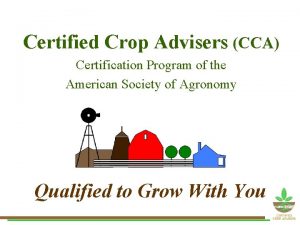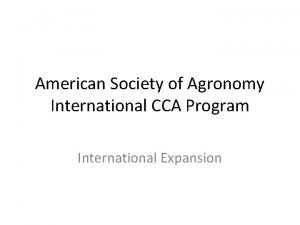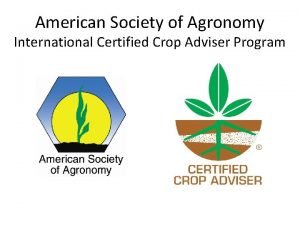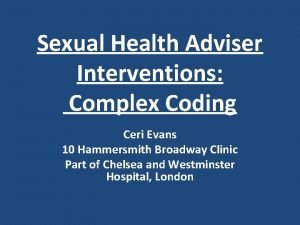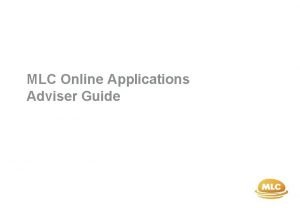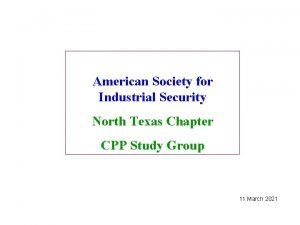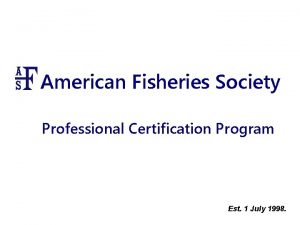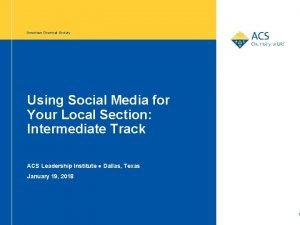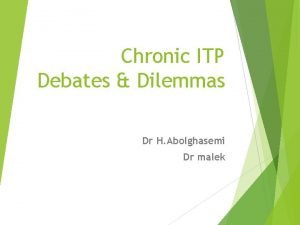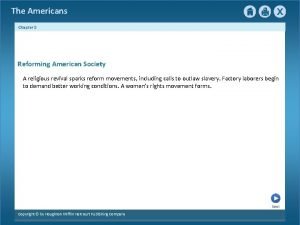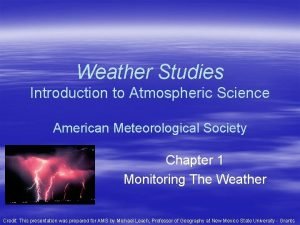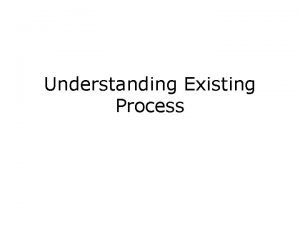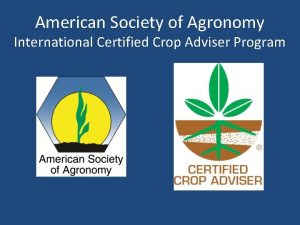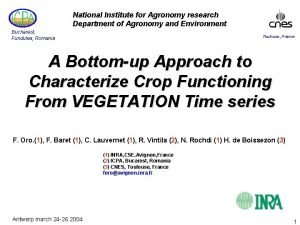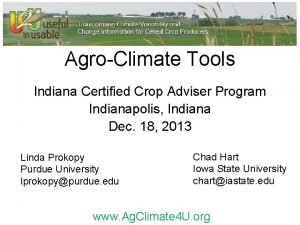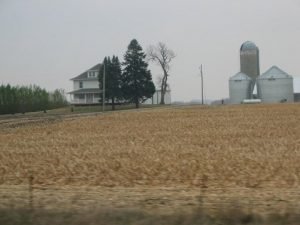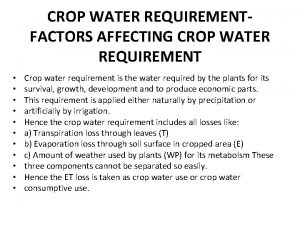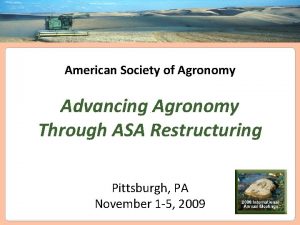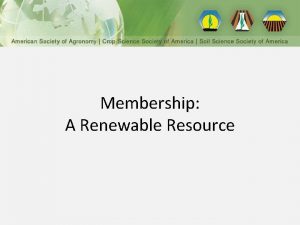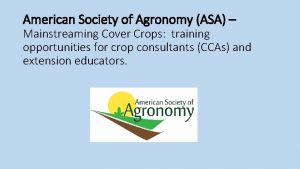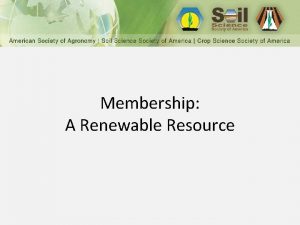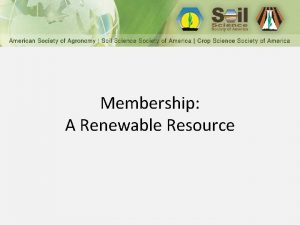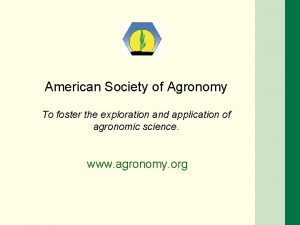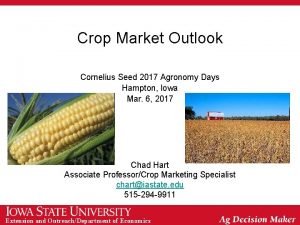American Society of Agronomy International Certified Crop Adviser

















- Slides: 17

American Society of Agronomy International Certified Crop Adviser Program

American Society of Agronomy (ASA) • Started in 1907 • 11, 000 members • Membership comprises: – Academia – Government – Industry or private sector

American Society of Agronomy (ASA) • Products and Services: – – Scientific Publications - Agronomy Journal Monthly Magazine – CSA News Quarterly Magazine – Crops and Soils World Class meetings • Latest research updates • Educational programs – Advocacy – Certification: • Certified Crop Adviser (CCA) • Certified Professional Agronomist (CPAg)

American Society of Agronomy (ASA) • Certifications: – protects the public and the profession – helps establish the profession through standards – enhances professional development • Certified Crop Adviser (CCA) • Certified Professional Agronomist (CPAg)


Certified Crop Adviser (CCA) Certified Professional Agronomist (CPAg) CCA CPAg • Exams • Education/Experience – BS – 2 yrs – Associate – 3 yrs – HS – 4 yrs • 2 references • Ethics • • • CCA BS minimum 5 years experience 5 references Ethics

Continuing Education CCA • • • 40 total CEUs/2 yrs Nutrient management Soil and water management IPM Crop management Professional Development CPAg • • 50 total CEUs/2 yrs Nutrient management Soil and water management IPM Crop management Professional Development Professional Service Professional Study

IPM Performance Objectives • COMPETENCY AREAS: 1. Basic Concepts of Pest Management 2. Sampling and Monitoring 3. Identification 4. Decision-Making Guidelines 5. Pest Management Strategies 6. Environmental Stewardship 7. Health and Safety • Pest Management Glossary

IPM Exam POs • https: //www. certifiedcropadviser. org/exams/i cca-performance-objectives • 77 competencies in IPM • Not only IPM also NM, SW, CM

IPM Continuing Education • https: //www. certifiedcropadviser. org/continu ing-education

CE – IPM - Examples a. Pesticide modes of action and pesticide interactions b. Proper use of crop protection products and label updates c. Emerging technologies for pest identification, survey, and damage estimates d. Novel pest control agents and strategies e. Evaluating the reliability of pest management information sources, decision making tools, and internet resources f. Using crop, pesticide, and environmental information to make pest management recommendations g. Biology of pests h. Economics of pest control strategies i. Managing pest resistance j. Management of new and emerging pests or changes in pest biology k. Trap crops

IPM - decision making skills a. Applying research and principles of modeling and forecasting to pest management b. Understanding, conducting and interpreting results of experimental trails c. Evaluating climate and management factors in pest control systems d. Evaluating non-traditional pest control methods e. In-field evaluations and management of cropping and pest management systems

IPM – application technologies a. Calibration, application, and advances in application technologies b. Precision agriculture technologies

IPM – other areas a. Grazing and pasture/range management for pasture/range pest control b. Wildlife habitat management c. Home and garden pesticide use d. Turf and ornamental IPM e. Organic production f. Horticulture

IPM – safety and environmental a. Environmental toxicology and signs and symptoms of exposure to toxins b. Pesticide use and food safety concerns c. Biosecurity in the agro-chemical industry d. Pesticide waste remediation e. Pesticide Safety, proper use, and label restrictions f. Effects of pesticide misuse on crops, wildlife and other non-target species or areas g. Wildlife as pests and methods of management

IPM – emerging areas a. Refugia management for biotechnology crops b. Segregation of herbicide tolerant or insect resistant crops c. Invasive species management d. Traits management e. Seed bank management f. Pest resistance g. Pest populations and species shifts h. Management of beneficials

Thank You • Luther Smith • Director of Certification and Licensing • 1 -608 -268 -4977 • lsmith@sciencesocieties. org
 Certified crop adviser certification
Certified crop adviser certification American society of agronomy cca
American society of agronomy cca Job market for certified crop advisors
Job market for certified crop advisors Manuel roxas economic advisor
Manuel roxas economic advisor Ucas adviser
Ucas adviser Ceri evans bournemouth
Ceri evans bournemouth Mlc adviser
Mlc adviser Office of the worker adviser
Office of the worker adviser Condo adviser
Condo adviser Gertler econ
Gertler econ American society for industrial security
American society for industrial security Certified fisheries professional
Certified fisheries professional American chemical society
American chemical society American society of hematology
American society of hematology American society of hematology
American society of hematology Chapter 8 reforming american society
Chapter 8 reforming american society Weather studies introduction to atmospheric science
Weather studies introduction to atmospheric science Existing process
Existing process
